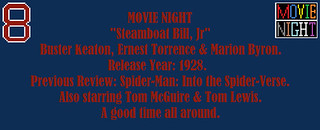
Review #1173: Steamboat Bill, Jr.
Cast:
Buster Keaton (William Canfield, Jr.), Ernest Torrence (William "Steamboat Bill" Canfield, Sr.), Marion Byron (Kitty King), Tom McGuire (John James King), and Tom Lewis (Tom Carter) Directed by Charles Reisner and Buster Keaton (#757 - Seven Chances, #762 - College, #805 - The Navigator, #877 - Three Ages, #908 - The General, #926 - Our Hospitality, #941 - Sherlock Jr, #1037 - Go West, and #1058 - Battling Butler)
Review:
Steamboat Bill, Jr (1928) was the tenth film with Buster Keaton as its main star along with director, although he was not credited for doing the latter unlike with other movies of his. He also reportedly wrote the story for the film, although only Carl Harbaugh was given credit for it. It also served as the last of his films to be distributed by United Artists, as he signed a deal with Metro-Goldwyn-Mayer, who would distribute Keaton's last two starring/directorial efforts (The Cameraman, which was released a few months after this film, and Spite Marriage, which was released the following year). In any case, the film was not an immediate success upon its release, but it has received a following of its own, much like with other Keaton films. It isn't too hard to see why, since Keaton manages to cobble an entertaining feature, filled with some fine gags, a few zippy title cards, and stunts that one would expect from Keaton. He does a fine job leading the way as one would expect, having fine timing and the right kind of expressions to go alongside the effective gags. Torrence does fine with his scenes with Keaton, evoking a few chuckles. Byron and McGuire are fine counterparts when needed in the story, although neither contribute too much in laughs. The characters (for which there aren't too many of) are fairly familiar types, but the film is charming enough to roll along with itself without too much time spent doing silly things. The climax is certainly an entertaining one. A good chunk of the budget (estimated to be around $300,000-$400,000) was spent on the cyclone sequence, having breakaway sets and wind machines. The original intent of the sequence was meant to depict a flood, but this was nixed by producer Joseph M. Schenck, in part because of the Mississippi River Flood that had occurred the previous year. It's a pretty impressive sequence, with the most notable part being where an entire building facade (with only the attic window being open) collapsing all around Keaton, which he did with no camera trickery. Even after nine decades since the film's release, it is still a sight to see, and it does invite chuckles (if not a bit of astonishment) that click with the other parts of the climax. On the whole, the film is a fairly enjoyable and generally consistent one that ranks up just fine with Keaton's other features; it may not be one of his best, but it is still one worth a look.
I want to close this review off by acknowledging that today is the eighth anniversary of the beginning of Movie Night. This show has had written reviews on a fairly consistent level in the 2,922 days from 2010 to 2018, averaging a review roughly every 2.5 days (or so the math says). Although the quantity of reviews has fluctuated over time, I will say that my passion for writing about films and watching them has not declined in the slightest. I wish to express my gratitude to anybody who has had the curiosity to check out this show over the years and anyone who has stuck around to check out what somebody on the Internet has to say about some random movie, whether good or bad. I hope that the years that follow lead to a continuation of interesting films to encounter and ponder about and that you are there to read all about it. Thank you for eight fine years. I would also like to wish you all a Merry Christmas and a Happy New Year.
Overall, I give it 8 out of 10 stars.

No comments:
Post a Comment